Fintech
Fintech

As Valentine’s Day approaches, hearts will melt, but some will inevitably be broken by romance scams. This season of love creates an opportune moment for scammers to prey on individuals feeling lonely or seeking connection. Financial institutions should take this time to warn customers about the heightened risks and encourage vigilance against fraud. In a tale as heart-wrenching as it is cautionary, a French woman named Anne was conned out of nearly $855,000 in a romance scam that lasted over a year. Believing she was communicating with Hollywood star Brad Pitt; Anne was manipulated by scammers who leveraged AI technology to impersonate the actor convincingly. Personalized messages, fabricated photos, and elaborate lies about financial needs made the scam seem credible. Anne’s story, though extreme, highlights the alarming prevalence and sophistication of romance scams in today’s digital age. According to the Federal Trade Commission (FTC), nearly 70,000 Americans reported romance scams in 2022, with losses totaling $1.3 billion—an average of $4,400 per victim. These scams, which play on victims’ emotions, are becoming increasingly common and devastating, targeting individuals of all ages and backgrounds. Financial institutions have a crucial role in protecting their customers from these schemes. The lifecycle of a romance scam Romance scams follow a consistent pattern: Feigned connection: Scammers create fake profiles on social media or dating platforms using attractive photos and minimal personal details. Building trust: Through lavish compliments, romantic conversations, and fabricated sob stories, scammers forge emotional bonds with their targets. Initial financial request: Once trust is established, the scammer asks for small financial favors, often citing emergencies. Escalation: Requests grow larger, with claims of dire situations such as medical emergencies or legal troubles. Disappearance: After draining the victim’s funds, the scammer vanishes, leaving emotional and financial devastation in their wake. Lloyds Banking Group reports that men made up 52% of romance scam victims in 2023, though women lost more on average (£9,083 vs. £5,145). Individuals aged 55-64 were the most susceptible, while those aged 65-74 faced the largest losses, averaging £13,123 per person. Techniques scammers use Romance scammers are experts in manipulation. Common tactics include: Fabricated sob stories: Claims of illness, injury, or imprisonment. Investment opportunities: Offers to “teach” victims about investing. Military or overseas scenarios: Excuses for avoiding in-person meetings. Gift and delivery scams: Requests for money to cover fake customs fees. How financial institutions can help Banks and financial institutions are on the frontlines of combating romance scams. By leveraging technology and adopting proactive measures, they can intercept fraud before it causes irreparable harm. 1. Customer education and awareness Conduct awareness campaigns to educate clients about common scam tactics. Provide tips on recognizing fake profiles and unsolicited requests. Share real-life stories, like Anne’s, to highlight the risks. 2. Advanced data capture solutions Implement systems that gather and analyze real-time customer data, such as IP addresses, browsing history, and device usage patterns. Use behavioral analytics to detect anomalies in customer actions, such as hesitation or rushed transactions, which may indicate stress or coercion. 3. AI and machine learning Utilize AI-driven tools to analyze vast datasets and identify suspicious patterns. Deploy daily adaptive models to keep up with emerging fraud trends. 4. Real-time fraud interception Establish rules and alerts to flag unusual transactions. Intervene with personalized messages before transfers occur, asking “Do you know and trust this person?” Block transactions if fraud is suspected, ensuring customers’ funds are secure. Collaborating for greater impact Financial institutions cannot combat romance scams alone. Partnerships with social media platforms, AI companies, and law enforcement are essential. Social media companies must shut down fake profiles proactively, while regulatory frameworks should enable banks to share information about at-risk customers. Conclusion Romance scams exploit the most vulnerable aspects of human nature: the desire for love and connection. Stories like Anne’s underscore the emotional and financial toll these scams take on victims. However, with robust technological solutions and proactive measures, financial institutions can play a pivotal role in protecting their customers. By staying ahead of fraud trends and educating clients, banks can ensure that the pursuit of love remains a source of joy, not heartbreak. Learn more

As data breaches become an ever-growing threat to businesses, the role of employees in maintaining cybersecurity has never been more critical. Did you know that 82% of data breaches involve the human element1 , such as phishing, stolen credentials, or social engineering tactics? These statistics reveal a direct connection between employee identity theft and business vulnerabilities. In this blog, we’ll explore why protecting your employees’ identities is essential to reducing data breach risk, how employee-focused identity protection programs, and specifically employee identity protection, improve both cybersecurity and employee engagement, and how businesses can implement comprehensive solutions to safeguard sensitive data and enhance overall workforce well-being. The Rising Challenge: Data Breaches and Employee Identity Theft The past few years have seen an exponential rise in data breaches. According to the Identity Theft Resource Center, there were 1,571 data compromises in the first half of 2024, impacting more than 1.1 billion individuals – a 490% increase year over year2. A staggering proportion of these breaches originated from compromised employee credentials or phishing attacks. Explore Experian's Employee Benefits Solutions The Link Between Employee Identity Theft and Cybersecurity Risks Phishing and Social EngineeringPhishing attacks remain one of the top strategies used by cybercriminals. These attacks often target employees by exploiting personal information stolen through identity theft. For example, a cybercriminal who gains access to an employee's compromised email or social accounts can use this information to craft realistic phishing messages, tricking them into divulging sensitive company credentials. Compromised Credentials as Entry PointsCompromised employee credentials were responsible for 16% of breaches and were the costliest attack vector, averaging $4.5 million per breach3. When an employee’s identity is stolen, it can give hackers a direct line to your company’s network, jeopardizing sensitive data and infrastructure. The Cost of DowntimeBeyond the financial impact, data breaches disrupt operations, erode customer trust, and harm your brand. For businesses, the average downtime from a breach can last several weeks – time that could otherwise be spent growing revenue and serving clients. Why Businesses Need to Prioritize Employee Identity Protection Protecting employee identities isn’t just a personal benefit – it’s a strategic business decision. Here are three reasons why identity protection for employees is essential to your cybersecurity strategy: 1. Mitigate Human Risk in Cybersecurity Employee mistakes, often resulting from phishing scams or misuse of credentials, are a leading cause of breaches. By equipping employees with identity protection services, businesses can significantly reduce the likelihood of stolen information being exploited by fraudsters and cybercriminals. 2. Boost Employee Engagement and Financial Wellness Providing identity protection as part of an employee benefits package signals that you value your workforce’s security and well-being. Beyond cybersecurity, offering such protections can enhance employee loyalty, reduce stress, and improve productivity. Employers who pair identity protection with financial wellness tools can empower employees to monitor their credit, secure their finances, and protect against fraud, all of which contribute to a more engaged workforce. 3. Enhance Your Brand Reputation A company’s cybersecurity practices are increasingly scrutinized by customers, stakeholders, and regulators. When you demonstrate that you prioritize not just protecting your business, but also safeguarding your employees’ identities, you position your brand as a leader in security and trustworthiness. Practical Strategies to Protect Employee Identities and Reduce Data Breach Risk How can businesses take actionable steps to mitigate risks and protect their employees? Here are some best practices: Offer Comprehensive Identity Protection Solutions A robust identity protection program should include: Real-time monitoring for identity theft Alerts for suspicious activity on personal accounts Data and device protection to protect personal information and devices from identity theft, hacking and other online threats Fraud resolution services for affected employees Credit monitoring and financial wellness tools Leading providers like Experian offer customizable employee benefits packages that provide proactive identity protection, empowering employees to detect and resolve potential risks before they escalate. Invest in Employee Education and Training Cybersecurity is only as strong as your least-informed employee. Provide regular training sessions and provide resources to help employees recognize phishing scams, understand the importance of password hygiene, and learn how to avoid oversharing personal data online. Implement Multi-Factor Authentication (MFA) MFA adds an extra layer of security, requiring employees to verify their identity using multiple credentials before accessing sensitive systems. This can drastically reduce the risk of compromised credentials being misused. Partner with a Trusted Identity Protection Provider Experian’s suite of employee benefits solutions combines identity protection with financial wellness tools, helping your employees stay secure while also boosting their financial confidence. Only Experian can offer these integrated solutions with unparalleled expertise in both identity protection and credit monitoring. Conclusion: Identity Protection is the Cornerstone of Cybersecurity The rising tide of data breaches means that businesses can no longer afford to overlook the role of employee identity in cybersecurity. By prioritizing identity protection for employees, organizations can reduce the risk of costly breaches and also create a safer, more engaged, and financially secure workforce. Ready to protect your employees and your business? Take the next step toward safeguarding your company’s future. Learn more about Experian’s employee benefits solutions to see how identity protection and financial wellness tools can transform your workplace security and employee engagement. Learn more 1 2024 Experian Data Breach Response Guide 2 Identity Theft Resource Center. H1 2024 Data Breach Analysis 3 2023 IBM Cost of a Data Breach Report

In today's evolving financial landscape and with delinquencies rising, debt collection remains a critical function for financial institutions. However, traditional methods often fall short in efficiency and customer satisfaction. Enter artificial intelligence (AI), a game-changer poised to revolutionize the debt collection industry. This blog post explores the benefits and uses of AI in debt collection, shedding light on how financial institutions can leverage this technology to enhance their strategies. Understanding AI in debt collection Artificial intelligence – which encompasses machine learning, natural language processing, and other advanced technologies – is transforming various industries, including debt collection. AI in debt collection involves using these technologies to automate and optimize processes, making them more efficient and effective. Examples of AI technologies in debt collection include chatbots, predictive analytics, and automated communication systems. Uses Predictive analytics Predictive debt collection analytics is a powerful tool in AI collections. By analyzing patterns and trends in debtor behavior, AI can forecast the likelihood of repayment. This information allows financial institutions to tailor their collection strategies to individual debtors, improving the chances of successful recovery. Chatbots and virtual assistants AI-powered chatbots and virtual assistants handle routine customer interactions, providing instant responses to common queries. These tools can escalate complex issues to human agents when necessary, ensuring that customers receive the appropriate level of support. By automating routine tasks, chatbots free up human agents to focus on more complex cases. Automated communication AI can automate communication with debtors, sending payment reminders and notifications through various channels such as email, SMS, and phone calls. These messages can be customized based on debtor profiles, ensuring that communication is personalized and effective. Automated communication helps maintain consistent contact with debtors, increasing the likelihood of timely payments. Benefits Improved operational efficiency One of the most significant advantages of AI in debt collection is improved operational efficiency. AI can automate repetitive tasks such as sending payment reminders and processing payments, reducing the need for manual intervention. This automation speeds up the process, reduces costs, and minimizes human errors, ensuring more accurate and timely collections. Enhanced customer experience AI-driven chatbots and virtual assistants can provide personalized communication, enhancing the customer experience. These AI tools are available 24/7, allowing customers to get instant responses to their queries at any time. By offering a seamless and responsive service, financial institutions can improve customer satisfaction and engagement strategies. Better decision making AI collections leverage predictive analytics to assess debtor risk and provide data-driven insights. This information enables financial institutions to develop more effective collection strategies and prioritize high-risk accounts. By making informed decisions based on predictive models, institutions can optimize collections processes and increase their chances of successful debt recovery. Cost savings Automation through AI can lead to significant cost savings. Financial institutions can achieve higher profitability by reducing the need for human intervention and lowering operational costs. Additionally, increased recovery rates due to better cure strategies contribute to overall cost efficiency. Challenges and considerations While AI offers numerous benefits, there are challenges and considerations to keep in mind. Data privacy and security are paramount, as financial institutions must ensure compliance with regulations such as General Data Protection Regulation (GDPR) and California Consumer Privacy Act (CCPA). Balancing automation with the need for a human touch is also crucial, as some customers may prefer interacting with human agents. Additionally, addressing potential biases in AI algorithms is essential to ensure fair and equitable treatment of all debtors. Future Trends in AI and debt collection The future of AI in debt collection looks promising, with emerging technologies poised to make a significant impact. Integration of AI with other technologies such as blockchain and the Internet of Things (IoT) could further enhance the efficiency and security of debt collection processes. As AI continues to evolve, financial institutions must stay abreast of these trends to remain competitive and effective in their collection strategies. Our debt management and collection solutions With more than 25 years of experience and a comprehensive suite of collection products, our enhanced decisioning, improved processes, and account prioritization can enable your organization to move toward a customer-centric approach that helps reduce losses and control costs. AI in debt collection offers a myriad of benefits, from improved efficiency and enhanced customer experience to better decision-making and cost savings. By leveraging AI technologies such as predictive analytics, chatbots, and automated communication, financial institutions can optimize their debt collection strategies and achieve higher recovery rates. As the industry continues to evolve, embracing AI will be crucial for financial institutions looking to stay ahead of the curve. Click below to learn more about how we can help your organization optimize your debt collection strategies to lose less and recover more. Learn more Watch our webinar on-demand This article includes content created by an AI language model and is intended to provide general information.
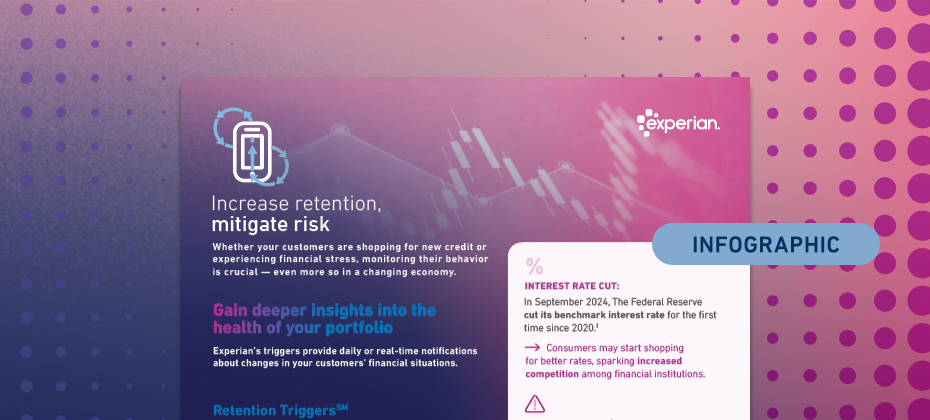
Whether consumers are shopping for new credit or experiencing financial stress, monitoring their behavior is crucial — even more so in an ever-changing economy. Our latest infographic explores economic trends impacting consumers’ financial behaviors and how Experian’s Risk and Retention TriggersSM enable lenders to detect early signs of risk or churn. Key highlights include: Credit card balances climbed to $1.17 trillion in Q3 2024. As prices of goods and services remain elevated, consumers may continue to experience financial stress, potentially leading to higher delinquency rates. Increasing customer retention rates by 5% can boost profits by 25% to 95%. View the infographic to learn how Risk and Retention Triggers can help you advance your portfolio management strategy. Access infographic

The credit card market is rapidly evolving, driven by technological advancements, economic volatility, and changing consumer behaviors. Our new 2025 State of Credit Card Report provides an in-depth analysis of the credit card landscape and strategy considerations for financial institutions. Findings include: Credit card debt reached an all-time high of $1.17 trillion in Q3 2024. About 19 million U.S. households were considered underbanked in 2023. Bot-led fraud attacks doubled from January to June 2024. Read the full report for critical insights and strategies to navigate a shifting market. Access report
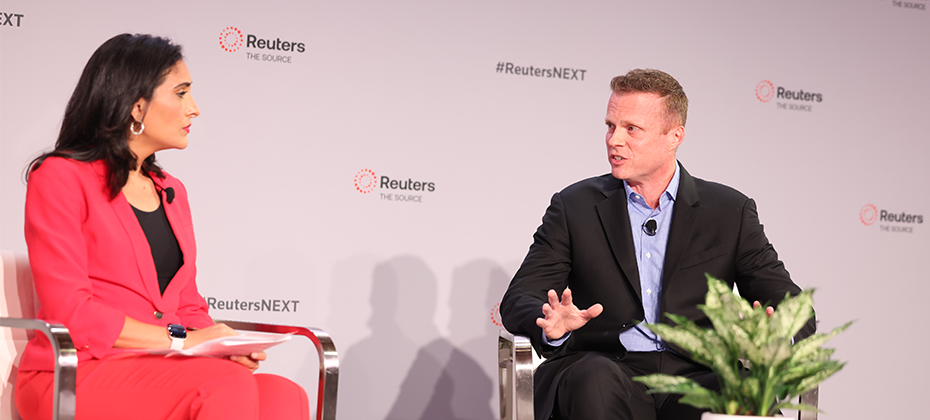
Scott Brown presents at Reuters Next “If I were to look into a crystal ball, traditional lending methodology and processes will not be replaced; they will be augmented by consumers connecting to banks via APIs, contributing the data they are comfortable with, and banks using that in conjunction with historical credit data to offer newer and better products they didn’t have access to before. The convergence of data, tech and AI leads to more financial inclusion and a more modern way of underwriting.”Scott Brown, Group President Financial Services, Experian North America Scott Brown, Group President of Financial Services for Experian North America, recently presented at Reuters Next discussing the transformative power of AI and data analytics in financial services. The session also covered the top challenges that financial institutions face today and how advances in technology are helping organizations overcome those challenges. This keynote presentation was a timely follow-up to Brown’s previous appearance at the Money20/20 conference in Las Vegas, where he revealed the details of Experian’s latest innovation in GenAI technology, Experian Assistant. Brown, in a conversation with TV writer, producer and anchor Del Irani, spoke about the ethical considerations of AI innovation, what the future of underwriting may look like, and how open banking can drive financial inclusion and have a significant positive impact on both businesses and consumers. “If you are extending a line of credit to a given consumer, how do you do so in a way that’s integrated into their everyday lives? That’s where the concept of embedded finance comes in, and how to embed finance into a consumer’s life, and not the other way around.”Scott Brown, Group President Financial Services, Experian North America By embedding finance into consumers’ lives, and not the other way around, organizations can develop better strategies to balance risk and generate more revenue. He also focused on three foundational steps to take advantage of the capabilities AI offers: data quality, transparency, and responsibility. Areas of focus for implementing AI As organizations rely on more sophisticated approaches, data quality inputs are more important than ever. Inaccurate data can lead to poor business decisions that can have a negative impact on organizations’ bottom line. Transparency is also a crucial component of implementing AI solutions. Companies should be able to explain how their models work and why the end results make sense while avoiding biases. Leveraging data with AI tools allows organizations to get a better view of the consumer, which is a goal of most banks and lending institutions. Using that consumer data responsibly is important for financial institutions to establish and maintain trust with the people who use their services. While incorporating AI solutions into everyday business operations is important for financial institutions to better serve their consumers and remain competitive in the industry, a lack of access to AI tools can prevent some organizations from doing so. A fragmented approach leads to higher costs, lower efficiency, and greater risk Until recently, financial institutions have had to rely on several different technology providers and tools to optimize customer experience and operational efficiency while protecting consumers from the risk of identity theft and fraud. This fragmented approach can result in increased costs for organizations and higher risk for consumers. Now, AI technology is solving this issue by integrating functionality into a single platform, such as the Experian Ascend Technology Platform™. This streamlined access to a comprehensive suite of tools can help accelerate time-to-value while also eliminating compliance risks. Full interview available now Brown’s full interview at Reuters Next reveals more details about how Experian is empowering organizations to better serve their consumers’ financial needs through AI innovation while also helping more than 100 million Americans who don’t have access to the mainstream credit ecosystem due to being credit invisible, unscoreable, or have a low credit score. Watch the full interview to learn more about how Experian is continuing to bring financial power to all through innovative technology. Watch the full interview now

Technology has dramatically transformed the financial services landscape, fostering innovation and enhancing operational efficiency. In an interview at this year’s Money20/20 conference, Scott Brown, Group President of Financial and Marketing Services for Experian, sat down with Fintech Futures’ North America Correspondent Heather Sugg to share how Experian is leveraging data, analytics, and artificial intelligence (AI) to modernize the financial services industry. During the discussion, Scott highlighted the recent launch of Experian Assistant — our newest generative AI tool designed to accelerate the modeling lifecycle, resulting in greater productivity, improved data visibility, and reduced delays and expenses. While Experian Assistant is a business-to-business solution built alongside our clients, Scott also noted its broader impact — helping increase credit access for underserved consumers. “At Experian, we’re really focused on addressing the underserved community who doesn’t have access to credit,” said Scott. “And we think that this tool helps lenders reach those customers in an easier way.” Learn more about Experian Assistant and watch our tech showcase to see the solution in action. Learn more Watch tech showcase

For businesses across all sectors solutions that improve productivity are more important than ever. As technology advances, organizations across industries are looking to capitalize by investing in artificial intelligence (AI) solutions. Studies have recently shown that productivity is a leading measure of how well these AI tools are performing. About 60% of organizations surveyed are using “improved productivity” as a metric to measure the success of implementing AI solutions.[1] Experian research shows it takes an average of 15 months to build a model and put it into production. This can hinder productivity and the ability to quickly go to market. Without a deep understanding of key data points, organizations may also have difficulty realizing time to value efficiently. To improve upon the modeling lifecycle, businesses must examine the challenges involved in the process. The challenges of model building One of the most significant challenges of the modeling lifecycle is speed. Slow modeling processes can cause delays and missed opportunities for businesses which they may have otherwise capitalized on. Another difficulty organizations face is having limited access to high-quality data to build more efficient models. Without the right data, businesses can miss out on actionable insights that could give them a competitive edge. In addition, when organizations have inefficient resources, expenses can skyrocket due to the need for experts to intervene and address ongoing issues. This can result in a steep learning curve as new tools and platforms are adopted, making it difficult for organizations to operate efficiently without outside help. Businesses can combat these challenges by implementing tools such as artificial intelligence (AI) to drive efficiency and productivity. The AI journey While generative AI and large language models are becoming more prevalent in everyday life, the path to incorporating a fully functional AI tool into an organization’s business operations involves multiple steps. Beginning with a proof of concept, many organizations start their AI journey with building ideas and use cases, experimentation, and identifying and mitigating potential pitfalls, such as inaccurate or irrelevant information. Once a proof of concept reaches an acceptable state of validity, organizations can move on to production and value at scale. During this phase, organizations will select specific use cases to move into production and measure their performance. Analyzing the results can help businesses glean valuable information about which techniques work most effectively, so they can apply those techniques to new use cases. Following successful iterations of an efficiently functioning AI, the organization can then implement that AI as a part of their business by working the technology into everyday operations. This can help organizations drive productivity at scale across various business processes. Experian’s AI journey has been ongoing, with years of expertise in implementing AI into various products and services. With a goal of providing greater insights to both businesses and consumers while adhering to proper consumer data privacy and compliance, Experian is committed to responsibly using AI to combat fraud and foster greater financial access and inclusion. Our most recent AI innovation, Experian Assistant, is redefining how financial organizations improve productivity with data-driven insights. Introducing Experian Assistant Experian Assistant, a new GenAI tool announced in October at Money20/20 in Las Vegas, is helping organizations take their productivity to the next level by drastically speeding up the modeling lifecycle. To drive automation and greater intelligence for Experian partners, Experian Assistant enables users to interact with a virtual assistant in real time and offers customized guidance and code generation for our suite of software solutions. Our experts – Senior Director of Product Management Ankit Sinha and Director of Analyst Relations Erin Haselkorn – recently revealed the details of how Experian Assistant can cut down model-development timelines from months to days, and in some cases even hours. The webinar, which took place on November 7th, covered a wide range of features and benefits of the new tool, including: Spending less time writing code Enhancing understanding of data and attributes Accelerating time to value Improving regulatory compliance A case study in building models faster Continental Finance Company, LLC’s Chief Data Scientist shared their experience using Experian Assistant and how it has improved their organization’s modeling capabilities: “With Experian Assistant, there is a lot of efficiency and improvement in productivity. We have reduced the time spent on data building by almost 75%, so we can build a model much quicker, and the code being generated by Experian Assistant is very high quality, enabling us to move forward much faster.” For businesses looking to accelerate their modeling lifecycle and move more quickly with less effort, Experian Assistant provides a unique opportunity to significantly improve productivity and efficiency. Experian Assistant tech showcase Did you miss the Experian Assistant Tech Showcase webinar? Watch it on demand here and visit our website to learn more. Visit our website [1] Forrester’s Q2 AI Pulse Survey, 2024
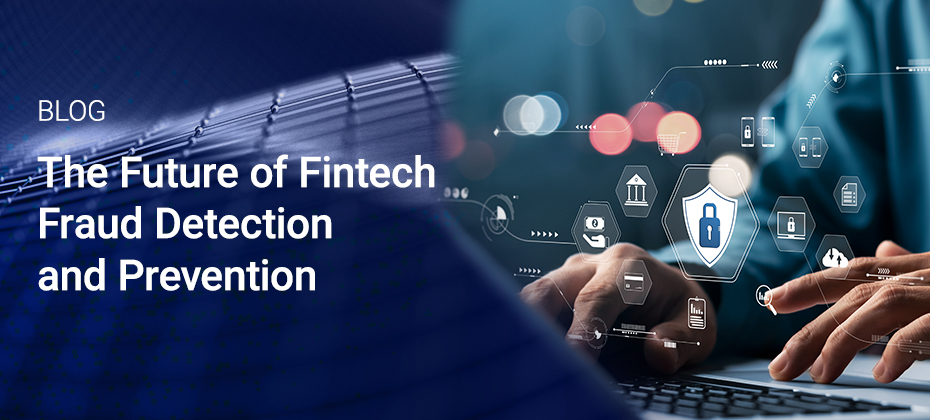
In this article...Understanding the scope of fintech fraudThe importance of fintech fraud preventionSynthetic identity (ID) fraud: A growing threatHow fintech fraud detection and prevention are evolvingGet started today The integration of technology with traditional financial services has unlocked unprecedented convenience and opportunities for consumers and businesses alike. However, this digital shift has opened the door for more sophisticated fraud tactics. With fraudsters continuously refining their methods, fintech companies must invest in advanced fintech fraud detection and prevention solutions. Understanding the scope of fintech fraud As fintech platforms expand, they also attract the attention of cybercriminals. The accessibility of digital financial services can create vulnerabilities that fraudsters exploit, executing everything from personal account takeovers to larger-scale breaches involving synthetic identities. Source: Experian’s U.S. Identity & Fraud Report To counter these threats, fintech companies must deploy innovative fraud management solutions powered by artificial intelligence (AI), machine learning (ML), and advanced analytics. Unlike traditional methods that often rely on static rules and manual reviews, these solutions can process vast amounts of data, learn from historical patterns, and detect anomalies in real-time. This allows organizations to identify suspicious activities before they lead to significant losses. The importance of fintech fraud prevention While detecting fraud is crucial, preventing it from occurring in the first place is even more important. Fraud prevention solutions aim to create robust systems that stop fraudsters in their tracks before they can cause damage. With the rise of digital financial services, the need for proactive fraud prevention measures has never been greater. These solutions protect both consumers and businesses from financial harm, reducing the risk of financial loss and reputational damage. Advanced fraud prevention solutions employ multilayered strategies, combining AI-driven fraud detection tools with methods such as multifactor authentication and biometric identity verification. These tools create an extra layer of security, making it difficult for fraudsters to access sensitive data or execute fraudulent transactions. Experian’s fraud prevention solutions offer businesses a comprehensive suite of tools designed to prevent various types of fraud. From real-time transaction monitoring to sophisticated user authentication methods, these solutions provide the protection businesses need to stay ahead of evolving fraud tactics. Synthetic identity (ID) fraud: A growing threat One of the most concerning forms of fraud that fintech companies face is synthetic ID fraud. This type of fraud involves the creation of a fake identity using a combination of real and fabricated information. Fraudsters often steal pieces of personal data — such as Social Security numbers or addresses—and then combine them with fictional information to create a new, synthetic identity. These synthetic identities can be used to open bank accounts, apply for credit cards, or take out loans, leaving businesses and consumers vulnerable to significant financial losses. Synthetic ID fraud is particularly difficult to detect because the synthetic identity often looks legitimate to traditional verification systems. As a result, fintech companies must deploy sophisticated fraud detection systems that can identify synthetic identities before they’re used to commit fraud. Machine learning algorithms, for instance, can analyze behavioral data, detecting discrepancies that may indicate a synthetic identity. Experian is ranked #1 by the Center for Financial Professionals (CeFPro®) for Identity and Fraud. The ranking appeared in CeFPro’s Fintech Leaders Report, a comprehensive annual study of the fintech industry. How fintech fraud detection and prevention are evolving As fraudsters continue to evolve their tactics, fintech companies must remain one step ahead by investing in cutting-edge fraud detection and prevention technologies. Real-time monitoring, predictive analytics, and biometrics are just a few of the technologies shaping the future of fraud detection. By integrating these technologies into their fraud management processes, fintech companies can offer a more secure and seamless experience for their users. With the acquisition of NeuroID, an industry leader in behavioral analytics, Experian has amplified its fraud risk suite by providing a new layer of insight into digital behavioral signals and analytics. Available through our fraud solutions on the Experian Ascend PlatformTM, clients can proactively monitor and analyze a user’s real-time digital behavior, allowing them to confidently navigate the online landscape and provide frictionless customer experiences. Get started today As the fraud landscape continues to evolve, fintech companies must adopt comprehensive solutions to stay ahead of emerging threats. By doing so, they can protect themselves and their customers, ensuring the continued success of digital financial services in the years to come. To learn more, check out our fraud management and fintech solutions. Fraud management solutions Fintech solutions
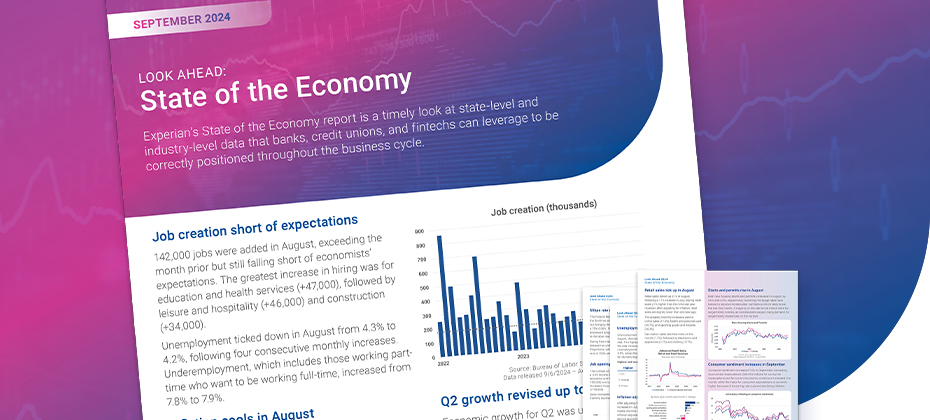
This series will explore our monthly State of the Economy report, which provides a snapshot of the top monthly economic and credit data for financial service professionals to proactively shape their business strategies. During their September meeting, the Federal Reserve made a highly-anticipated announcement to cut rates for the first time since 2020. Fed officials cut rates by 50bps, while also penciling in an additional 50bps of cuts for 2024 and 100bps of cuts in 2025 in their Summary of Economic Projections. While rates are coming down and inflation continues to cool, there were downward revisions to job creation made in August and declining job openings in July. Data highlights from this month’s report include: The Federal Reserve announced a 50bps rate cut during the September meeting. Annual headline inflation cooled from 2.9% to 2.5%, getting closer to the Fed’s 2% goal. Mortgage originations increased 7.0% in August. Check out our report for a deep dive into the rest of this month’s data, including the latest trends in job creation, retail sales, and consumer sentiment. Download September's report As our economy continues to fluctuate, it's critical to stay updated on the latest developments. Subscribe to our new series, The Macro Moment, for economic commentary from Experian North America's Chief Economist, Joseph Mayans, and download our new Lending Conditions Chartbook for additional insights. For more economic trends and market insights, visit Experian Edge.
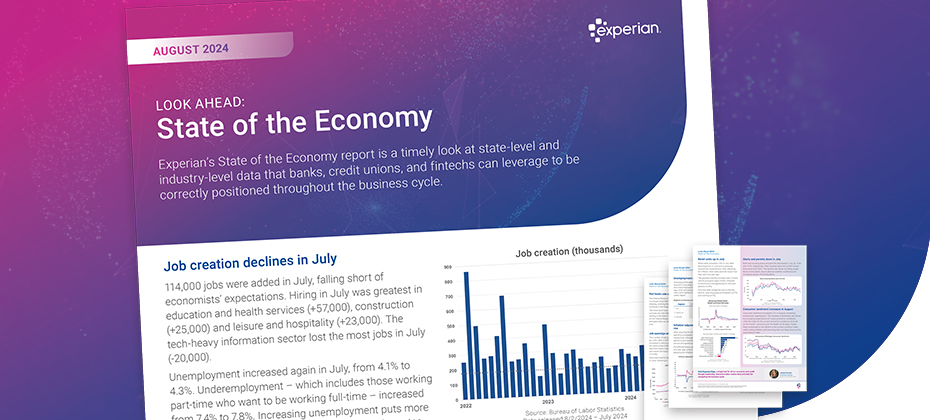
This series will dive into our monthly State of the Economy report, providing a snapshot of the top monthly economic and credit data for those in financial services to proactively shape their business strategies. The labor market has been a source of strength for the U.S. economy coming out of the pandemic, providing workers with stable employment and solid wages. However, the labor market has slowed in recent months, with lower-than-expected job creation and rising unemployment, causing weakening sentiment in the broader market. This has resulted in increased pressure on the Federal Reserve to begin cutting rates and places more importance on the incoming data between now and the September FOMC meeting. Data highlights from this month’s report include: Job creation declined in July, falling short of economists’ expectations. Unemployment increased from 4.1% to 4.3%. Inflation cooled again in July, with annual headline inflation easing from 3.0% to 2.9%. GDP picked up in Q2 to 2.8%, primarily driven by strong consumer spending. Check out our report for a deep dive into the rest of this month’s data, including the latest trends in originations, retail sales, and the new housing market. Download August's report To have a holistic view of our current environment, it’s important to view the economy from different angles and through different lenses. Download our latest macroeconomic forecasting report for our views on what's to come in the U.S. economy and listen to our latest Econ to Action podcast. For more economic trends and market insights, visit Experian Edge.

Alternative lending is continuing to revolutionize the financial services landscape. From full-file public records to cash flow transactions, alternative credit data empowers financial institutions to make more informed lending decisions. This article focuses on cash flow insights and how they help financial institutions drive profitable and inclusive growth. Challenges with traditional credit underwriting Traditional underwriting often limits access to credit for marginalized communities, including young adults, immigrants, and those from low-income backgrounds. Because the process relies heavily on credit history and credit scores to determine an applicant’s ability to pay, those with less-than-ideal credit profiles could be overlooked. This then creates a cycle — those who are already disadvantaged face further barriers to accessing credit, limiting their abilities to invest in opportunities that can improve their financial situations, such as education or homeownership. Additionally, traditional underwriting models can be rigid. Consumers with stable incomes or significant assets may be denied credit if their financial profiles don’t fit the narrow criteria established by traditional models. As the financial landscape evolves, it’s important for lenders to adopt more inclusive and adaptive approaches to credit underwriting. What is cash flow underwriting? Cash flow underwriting is a modern approach to evaluating a borrower’s creditworthiness. It uses fresh, consumer-permissioned bank account transaction (balance, income and expense) data, giving lenders greater visibility into loan applicants’ financial situation. This process is made possible through open banking, an established, secure framework that enables consumers to quickly and easily share their bank account information with third-party financial service providers. READ: Learn more about the open banking landscape. Let’s look at a few quick examples: A prospective tenant is filling out a rental application. Instead of manually submitting paystubs to verify their income, open banking facilitates the digital sharing of full cash flow data in seconds, enabling property managers to quickly access the applicant’s full cash flow information. A consumer was previously denied credit due to insufficient credit history. With cash flow underwriting, the consumer is offered a second chance to qualify for the loan by including cash flow data in the lender’s decisioning model. The additional information gathered on the consumer’s ability to pay can transform the initial decline decision into an approval. Cash flow underwriting can also be used for credit line management. By assessing a borrower’s income and expense transactions, lenders can recommend optimal credit limits that cater to their spending potential while minimizing risk. Benefits of cash flow underwriting There are many benefits to integrating cash flow data into the credit underwriting process, including: Enhanced risk assessment. Going off credit scores and repayment behaviors alone won’t provide lenders with a complete or current picture of applicants. Through open banking, lenders can gain access to cash flow data in real-time, allowing them to more accurately assess consumers, increase approvals, and reduce credit risk. Inclusive lending. Millions of American adults are considered unscoreable, invisible, or subprime. However, 71% of consumers are willing to share their banking information if it could improve their chances of getting approved for credit.1 With deeper insights into consumers’ income and expenses, lenders can increase credit access in underserved communities. Improved customer experiences. Gaining a more comprehensive view of a consumer’s financial situation enables lenders to determine what loan products they’re eligible for and craft personalized options. READ: Learn more about the benefits of leveraging alternative data for credit underwriting. Get started Cash flow underwriting represents a significant step forward in the world of lending. It offers a more comprehensive approach to assessing creditworthiness, helping financial institutions drive growth and profitability. Cashflow Attributes are one of Experian's open banking solutions that provides lenders with consumer-permissioned insights into borrowers’ financial behaviors. With 940+ attributes derived from transaction data across 133 categories, financial institutions can make smarter, more inclusive lending decisions. Learn more about Cashflow Attributes Learn more about open banking 1Atomik Research survey of 2,005 U.S. adults online, matching national demographics, 2024.

Gen Z, or "Zoomers," born from 1997 to 2012, are molded by modern transformations. They have witnessed events from post-9/11 impacts to the rise of the internet and the COVID-19 crisis. As early adopters of technology, their lives are intertwined with smartphones, online shopping, social platforms, cloud services, emerging fintech, and artificial intelligence. They are called “digital natives” as they are the first generation to grow up with internet as part of their daily life. Research generally indicates that this post-millennial generation values practicality, favoring financial stability over entrepreneurial pursuits. They appreciate communication tailored to them and often employ social media to cultivate their personal brands. As a generation growing up immersed in technology, they tend to choose digital interactions, seeking to forge robust, secure, genuine, and unconstrained digital experiences. The challenge of identity verification Identity verification presents a considerable challenge for Generation Z. According to a Fortune survey, close to 50% of this demographic regrets not opening financial accounts earlier, citing a lack of readiness to join the financial ecosystem by the age of 18. Consequently, this has given rise to "digital ghosts"—people with minimal or nonexistent financial histories who face challenges when trying to utilize financial services. The 2009 Credit Card Accountability Responsibility and Disclosure Act mandates that individuals under 21 need a cosigner or show income proof to get a credit card, hindering their early financial involvement. Moreover, conventional identity checks are becoming less reliable due to the surge in identity theft. Innovative solutions for verifying Gen Z Verifying identities and preventing fraud among Gen Z presents unique challenges due to their digital-native status and limited credit histories. Here are some effective strategies and approaches that financial institutions can adopt to address these challenges: Leveraging alternative data sources Academic records leverage information from higher learning institutions such as universities, colleges, and vocational schools. This data can be vital for authenticating the identities of younger individuals who may lack a substantial credit history. Employment verification retrieve data confirming the identity and employment status, especially focusing on Gen Z who are new to the job market. Utility and telecom records leverage payment histories for utilities, phone bills, and other recurring services, which can provide additional layers of identity verification. Alternative financial data includes online small dollar lenders, online installment lenders, single payment, line of credit, storefront small dollar lenders, auto title and rent-to-own. Phone-Centric ID Phone-Centric Identity refers to technology that leverages and analyzes mobile, telecom, and other signals for the purposes of identity verification, identity authentication, and fraud prevention. Phone-Centric Identity relies on billions of signals from authoritative sources pulled in real time, making it a powerful proxy for digital identity and trust. Advance authentication technologies Behavioral biometrics analyze user behaviors such as typing patterns, navigation habits, and device usage. These subtle behaviors can help create a unique profile for each user, making it difficult for fraudsters to impersonate them. Adaptive risk-based authentication that adjusts the level of security based on the user's behavior, location, device, and other factors. For example, a higher level of verification might be required for transactions that are deemed unusual or high-risk. Real-time fraud detection AI and machine learning: Deploy AI and machine learning algorithms to analyze transaction patterns and detect anomalies in real-time. These technologies can identify suspicious activities and flag potential fraud. Fraud analytics: Use predictive analytics to assess the likelihood of fraud based on historical data and current behavior. This approach helps in proactively identifying and mitigating fraudulent activities. Secure digital onboarding Digital identity verification: Implement digital onboarding processes that include online identity verification with real-time document verification. Users can upload government-issued IDs and take selfies to confirm their identity. Video KYC (Know Your Customer): Use video calls to conduct KYC processes, allowing bank representatives to verify identities and documents remotely via automated identity verification. This method is secure and convenient for tech-savvy Gen Z customers. Make identity verification easy To authenticate identities and combat fraud within the Gen Z population, financial organizations need to implement a comprehensive strategy utilizing innovative technologies, non-traditional data, and strong protective protocols. Such actions will enable the creation of a trustworthy and frictionless banking environment that appeals to a generation adept in digital interactions, thereby establishing trust and encouraging enduring connections. To learn more about Experian’s automated identity verification solutions, visit our website. Learn more

Getting customers to respond to your credit offers can be difficult. With the advent of artificial intelligence (AI) and machine learning (ML), optimizing credit prescreen campaigns has never been easier or more efficient. In this post, we'll explore the basics of prescreen and how AI and ML can enhance your strategy. What is prescreen? Prescreen involves evaluating potential customers to determine their eligibility for credit offers. This process takes place without the consumer’s knowledge and without any negative impact on their credit score. Why optimize your prescreen strategy? In today's financial landscape, having an optimized prescreen strategy is crucial. Some reasons include: Increased competition: Financial institutions face stiff competition in acquiring new customers. An optimized prescreen strategy helps you stand out by targeting the right individuals with tailored offers, increasing the chances of conversion. Customer expectations: Modern customers expect personalized and relevant offers. An effective prescreen strategy ensures that your offers resonate with the specific needs and preferences of potential customers. Strict budgets: Organizations today are faced with a limited marketing budget. By determining the right consumers for your offers, you can minimize prescreen costs and maximize the ROI of your campaigns. Regulatory compliance: Compliance with regulations such as the Fair Credit Reporting Act (FCRA) is essential. An optimized prescreen strategy helps you stay compliant by ensuring that only eligible individuals are targeted for credit offers. Financial inclusion: 49 million American adults don’t have conventional credit scores. An optimized prescreen strategy allows you to send offers to creditworthy consumers who you may have missed due to a lack of traditional credit history. How AI and ML can enhance your strategy AI and ML can revolutionize your prescreen strategy by offering advanced analytics and custom response modeling capabilities. AI-driven data analytics AI analytics allow financial institutions to analyze vast amounts of data quickly and accurately. This enables you to identify patterns and trends that may not be apparent through traditional analysis. By leveraging data-centric AI, you can gain deeper insights into customer behavior and preferences, allowing for more precise targeting and increased response rates. LEARN MORE: Explore the benefits of AI for credit unions. Custom response modeling Custom response models enable you to better identify individuals who fall within your credit criteria and are more likely to respond to your credit offers. These models consider various factors such as credit history, spending habits, and demographic information to predict future behavior. By incorporating custom response models into your prescreen strategy, you can select the best consumers to engage, including those you may have previously overlooked. LEARN MORE: AI can be leveraged for numerous business needs. Learn about generative AI fraud detection. Get started today Incorporating AI and ML into your prescreen campaigns can significantly enhance their effectiveness and efficiency. By leveraging Experian's Ascend Intelligence Services™ Target, you can better target potential customers and maximize your marketing spend. Our optimized prescreen solution leverages: Full-file credit bureau data on over 245 million consumers and over 2,100 industry-leading credit attributes. Exclusive access to the industry's largest alternative datasets from nontraditional lenders, rental data inputs, full-file public records, and more. 24 months of trended data showing payment patterns over time and over 2,000 attributes that help determine your next best action. When it comes to compliance, Experian leverages decades of regulatory experience to provide the documentation needed to explain lending practices to regulators. We use patent-pending ML explainability to understand what contributed most to a decision and generate adverse action codes directly from the model. For more insights into Ascend Intelligence Services Target, view our infographic or contact us at 855 339 3990. View infographic This article includes content created by an AI language model and is intended to provide general information.
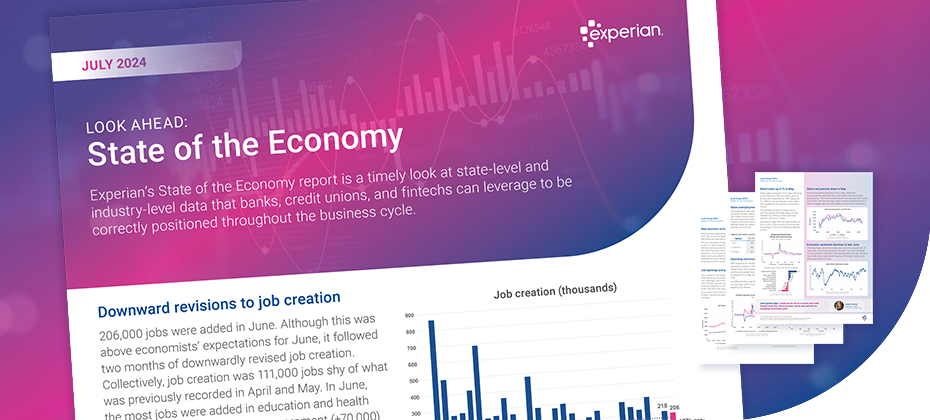
This series will dive into our monthly State of the Economy report, providing a snapshot of the top monthly economic and credit data for those in financial services to proactively shape their business strategies. While much of the economic data released this month remained steady, including continued downward progress in inflation and resilience in inflation-adjusted spending, June was a pivotal month for the labor market. With downward revisions to job creation over the past few months to an up-tick in unemployment, the potential for a sooner-than-expected rate cut increased. Data highlights from this month’s report include: While above economists’ expectations in June, job creation was 111,000 jobs shy of what was recorded in April and May, signaling some slowdown in the labor market. Inflation-adjusted spending and incomes increased in May, by 0.3% and 0.5%, respectively. Inflation eased more than economists expected, with annual headline inflation cooling from 3.3% to 3.0%. Check out our report for a deep dive into the rest of this month’s data, including the latest trends in job openings, new business survival rates, and bankcard delinquency rates. Download July's report To have a holistic view of our current environment, it’s important to view the economy from different angles and through different lenses. Watch our experts discuss the latest economic and credit trends in the next macroeconomic forecasting webinar and listen to our latest Econ to Action podcast. For more economic trends and market insights, visit Experian Edge.